March Madness is just around the corner, and while we’re waiting to see how this year’s basketball team will do, we wanted to find out how some of the best Runnin’ Utes of the past would fare when pitted against each other.
We selected 16 teams from a variety of basketball eras and seeded them according to their regular season winning percentage. For each matchup, one of our writers researched the respective team’s stats, star players, and more in order to determine a winner.
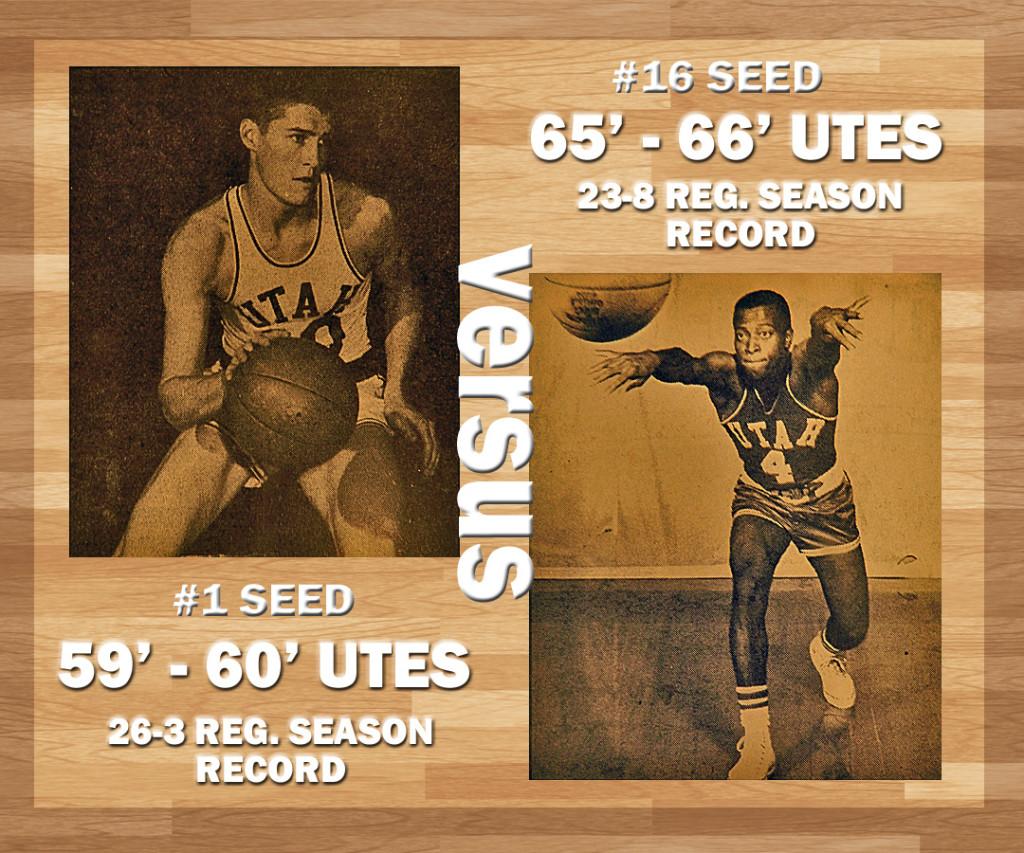
by Brock Jensen
It hasn’t happened yet, and we’re not going to start now at The Chronicle. There’s not going to be a crazy 16-seed upset over a 1-seed for this matchup. Though I am convinced that at some point in the future we will see this happen — and what an exciting game that will be — it’s not happening here.
The ‘59-‘60 Utes are the first seed for a reason and easily win this matchup. The team went 26-3 under all-time great head coach Jack Gardner, who the court in the Huntsman Center is named after. In this bracket matchup, they beat the ‘65-‘66 Utah basketball team. Though this 23-win team is far from what you actually see in a 16-seed, it wasn’t enough to justify an upset of this magnitude.
The ’59-’60 Utes made an appearance in the Sweet Sixteen, while also taking the crown as champion of the Mountain States Conference. Chalk this up as your typical March Madness first round victory for the 1-seed.
WINNER: 59′ – 60′ Utes
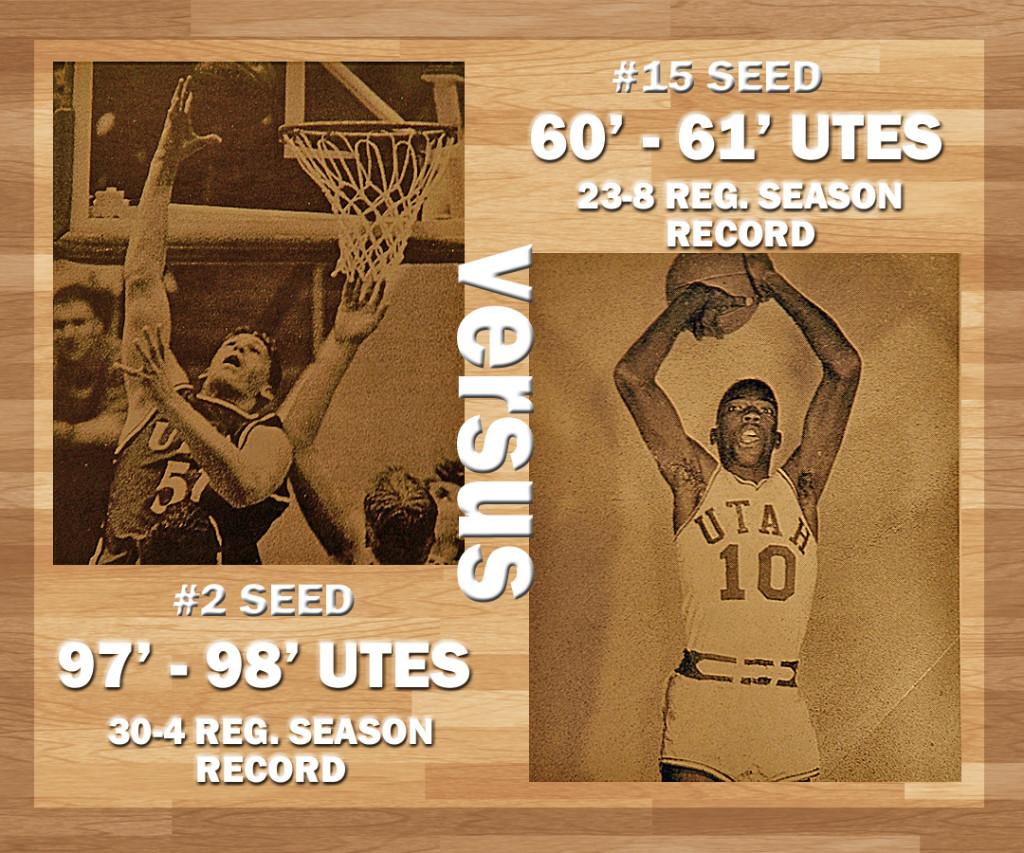
by Joseph Coles
The 1960-61 Utes were coached by Jack Gardner, who led them to a 23-8 overall record and the MSAC championship. Junior Billy “The Hill” McGill, who averaged 27.8 points per game, led the Utes. McGill still holds the record for total rebounds in a season when he grabbed 430 rebounds in 1960-61. The team ranks seventh in Utah history for total points scored and fourth in total rebounds. Utah made it to the 1961 Final Four but fell to Cincinnati in the semifinal.
The 1997-98 Utes had a legendary lineup: Andre Miller, Michael Doleac, Alex Jensen, Drew Hansen and Hanno Mottola. Utah finished 30-4 (12-2 in the WAC). The legendary Rick Majerus coached the 1997-98 Utes to a 30-win season, tied for most wins in school history.
In the Elite Eight, the Utes thrashed No. 1 Arizona 76-51 to punch their ticket to the Final Four, then Utah defeated North Carolina in the semifinal 65-59, surviving a late-game Tar Heel rally to go to the national championship. In the championship, Kentucky led Utah by 10 at halftime, but the Comeback Cats outscored the Utes 47-28 in the second half to win the title 78-69.
The 1997-98 team was just the second Utah squad ever to make it to a championship game, so led by do-it-all point guard Miller, it advances with an easy win over the ‘60-’61 team.
WINNER: 97′ – 98′ Utes
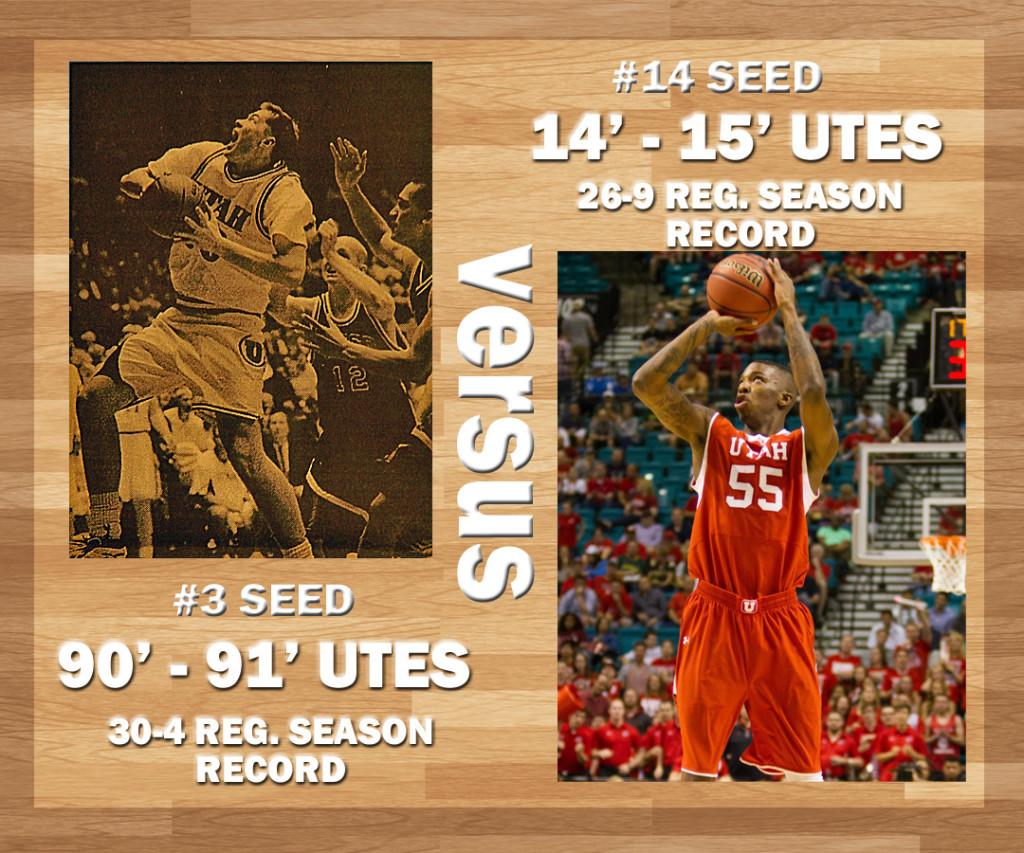
by Kim Brenneisen
Both teams made it to the Sweet Sixteen, and while it is certainly hard to deny how great last season’s squad was with Delon Wright at the forefront, the better team is the ’90-’91 Utes.
First of all, you could never go wrong picking legendary Utah head coach Rick Majerus. The mindset he instilled in his team is like none other. Current head coach Larry Krystkowiak could surely make his way into the ranks of someone like Majerus, but time has yet to tell whether that will happen.
Yes, last year’s team may have had a tougher conference schedule, but it says more about a team playing in a lower-level conference to make it that far to the Sweet 16. Majerus revived the Utah program and made it somewhat of a powerhouse in the West.
Aside from Majerus, this team was led by Josh Grant, who had his own storied career at Utah and has the third most career points. It’s a tough matchup, but the ’90-’91 Utes would come out on top.
WINNER: ’90 – ’91 Utes
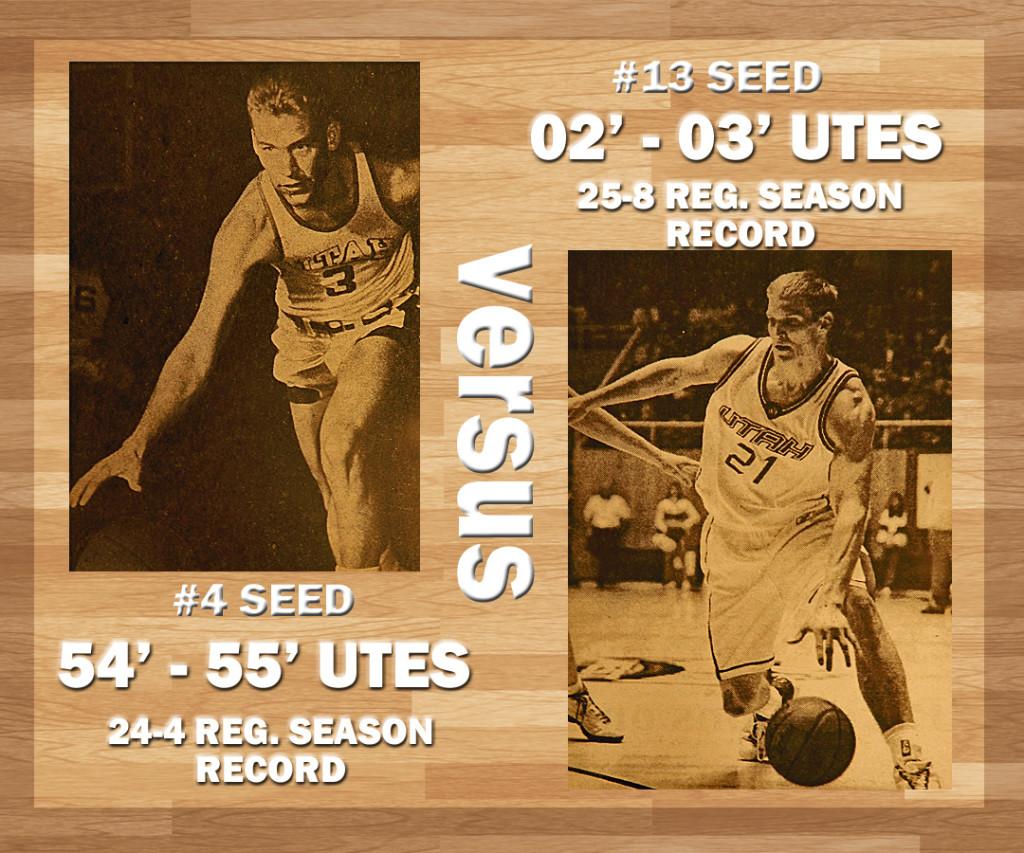
by Armen Shrikian
The No. 4-seed ’54-’55 Runnin’ Utes (24-4) were also coached by Gardner, who was especially known for his quick offenses, leading to Utah creating the “Runnin’ Utes” nickname. Gardner’s Runnin Utes’ averaged 78.9 points per game while allowing only 59.9 points per game. These Utes’ fell in the Sweet Sixteen, though, 78-59 to the (29-0) San Francisco Dons, who were led by NBA hall of famer Bill Russell. The ’54-’55 Runnin’ Utes rebounded to defeat Seattle 108-85 in the regional third-place game.
The 02’-03’ Runnin Utes team (25-8) were led by none other than Majerus, who compiled a 323-95 record during his time as Utah head coach. The Runnin’ Utes were eliminated from the Big Dance in the second round, losing 74-54 to Kentucky.
In a head-to-head matchup, Gardner’s team would come out ready to run, most likely jumping out to an early lead. But just like any Majerus-led team, the head coach would spark some energy and inspiration into his team, cutting the lead down in the second half. But Gardner’s team would ultimately use its stellar offensive schemes to protect the lead, finishing with with the victory to advance to the next round.
WINNER: ’54 – ’55 Utes
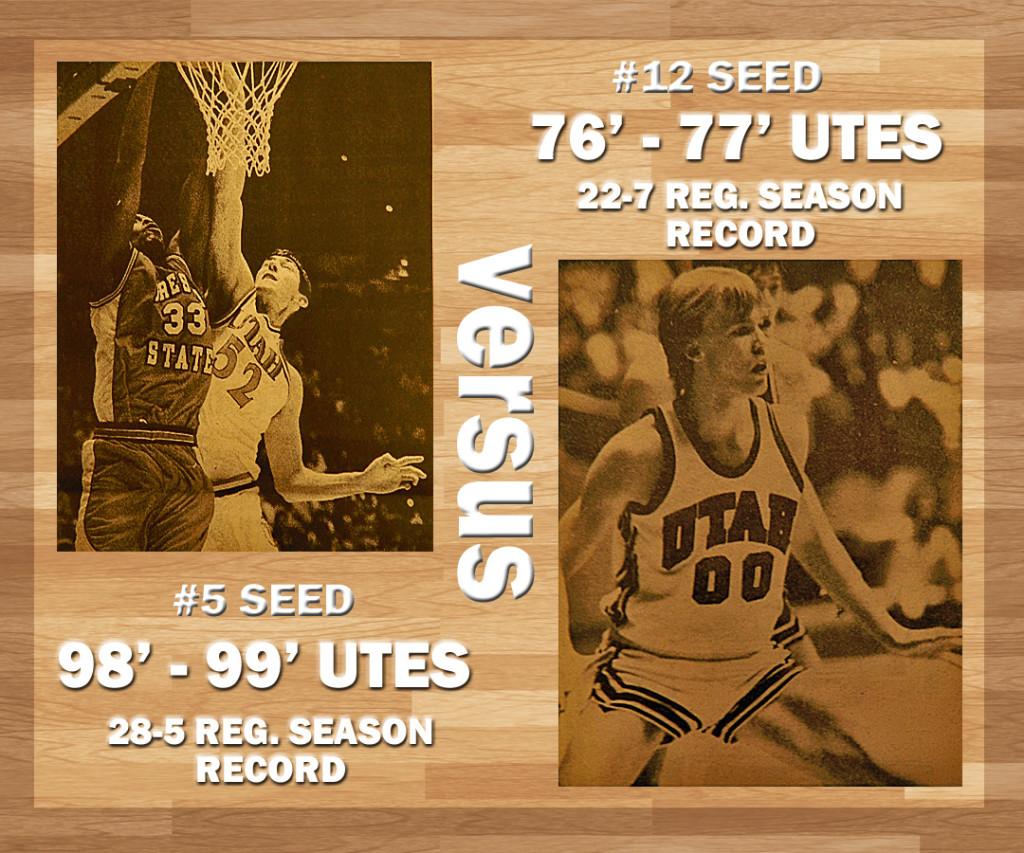
by Chad Marquez
Coming off a year where the Utes were one win away from a national championship, there was a lot of pressure on head coach Majerus and the ’98-’99 team to repeat or even do better. With returning star Andre Miller, the pressure to deliver was definitely on.
Unfortunately the team only made it to the second round of the NCAA Tournament, but had a terrific 28-5 record that kept this team in the conversation. The team’s leaders also stepped up to help the Utes win the Mountain West once again, with Miller earning his second-highest amount of assists and career-high in steals over the course of the season.
Meanwhile, the ’76-’77 season was also a big period for the Utes, being one of the only successful years the program had in almost a decade.
Led by head coach Jeremy Pimm, Jeff Judkins and Jeff Jonas, the team was thrown back into the college basketball conversation after earning a 22-7 record and winning the WAC before being knocked out once again in the Sweet 16.
The team had one of the the highest field goal percentages in school history, scoring a season average 81.7 points per game, one of the bests stats out of all these teams in that category.
With a lot of buzz and pressure surrounding the ’98-’99 team, they delivered below expectations. But with the high class players that this team possessed, and having a 15.9 point difference over the course of the season, this Utah team takes the cake over the team from the 70’s.
WINNER: 98′ – 99′ Utes
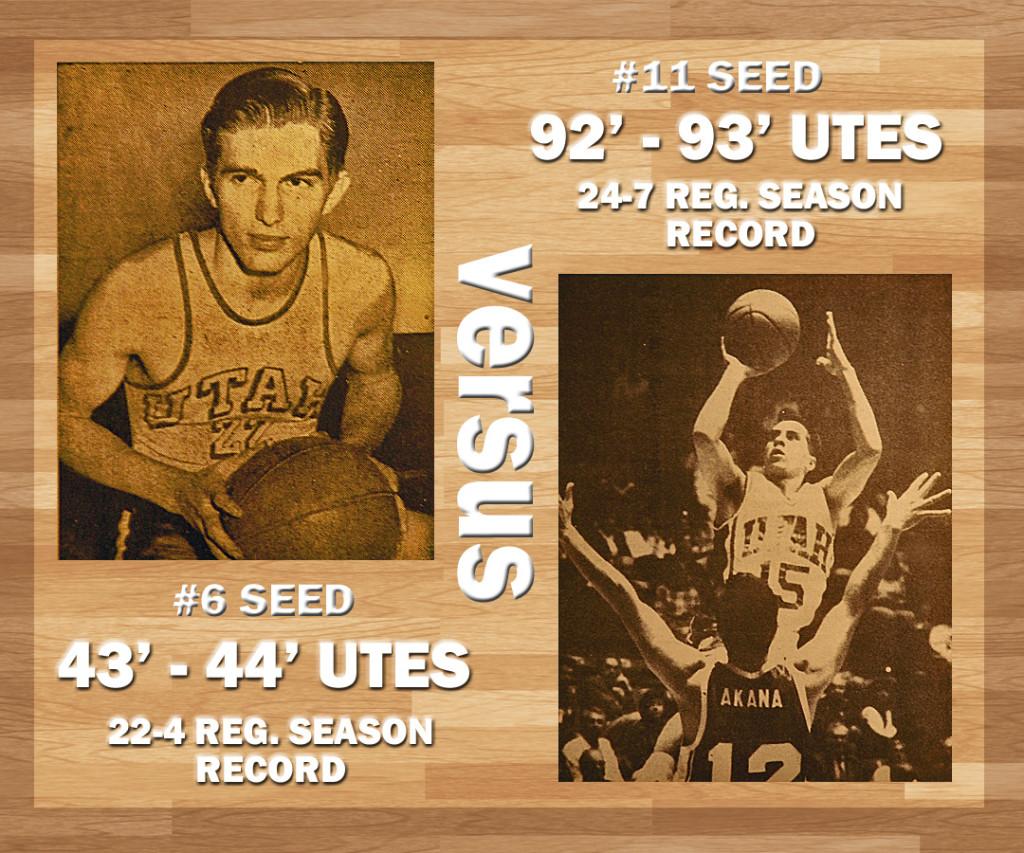
by Tyler Crum
This matchup is old-school versus new-school basketball at its finest, as it pits the 1944 National Champions against a standout 1992-93 squad coached by the sweater-clad all-time great coach Rick Majerus. As great as Majerus was, the 1943-44 team would walk away with a hypothetical victory because of that team’s sheer determination in the face of adversity and its clutch performance as the NCAA tournament’s first true Cinderella team.
At a time when most schools didn’t even try to field a team, a hodge-podge collection of freshmen and players who were medically disqualified from the draft assembled together and overcame the wartime challenges to make their way to the NCAA Championships and beat heavily-favored Dartmouth in a 42-40 overtime victory.
The ’92-’93 Utes were very talented in their own right, as the high-scoring, run-and-gun style WAC champions upset Pittsburgh to make it to the second round of the NCAA tournament and was led by two-time conference player of the year and second round NBA draft pick Josh Grant.
A huge factor in determining the outcome of this game would be the rules by which it is played. The game changed a tremendous amount during the half-century that separates these two teams, as the ’43-’44 Utes played at a time when the average college player was much smaller, the team was free to run their offense without the constraint of a shot clock, and the three-point shot was just a radical idea. Whereas the ’92-’93 team was tremendously efficient at running a fast-paced offense and was third in the nation in field goal shooting percentage beyond the arc.
In spite of this, the tremendous fortitude of the ’43-’44 Utes and their uncanny luck might just give them the edge to move on to the next round.
WINNER: ’43 – ’44 Utes

by Westin Porter
In all honesty, this matchup wouldn’t really be a matchup. While the ’55-’56 Utes touted intimidating names like Morris Buckwalter and Art Bunte (names that sound more like 1950s motorcycle gang members, à la Marlon Brando in The Wild Ones), their 1980-81 counterparts played a game that benefitted from both years of natural evolution and sophistication, as well as existing in an era in which half the available talent was now allowed to play in African-American athletes.
The 1980-81 Utes stomped their way to the West Regional Semifinal on the heels of a 13-3 WAC record. Future NBA All-Star Tom Chambers (flowing mullet yet to blossom into one of the finest heads of hair the League has ever seen) led the pack, averaging nearly 19 points and nine rebounds per game. Chambers rarely passed the ball, but when you have the silky jumpshot to match the flowing 1980s Baywatch locks of golden hair, you don’t pass, you shoot — 59 percent from the floor.
Imagine the ‘55 Utes walking onto the modern Huntsman floor bemused by the strange arc that surrounds each hoop 19.75 feet away, the foreign 24-second clock ticking away, and the presence of non-white basketball players. The Chambers-led 80-81 Utes, on the other hand, would laud the applause of modern fans with their retro hair cuts and high-thigh riding crimson shorts.
Chambers would drop 50, relishing in the bonus point given to shots made behind the new three-point line, and would unleash a furious hammerdunk on the likes of the 6-foot-8, 200-pound bean-pole Gary Bergen. The ’80-’81 Utes would waltz effortlessly past their 1956 counterparts, who would then slink back into an era without three-point lines, Starbucks or hoverboards … Wait, Morris Buckwalter, take me with you!
WINNER: 80′ – 81′ Utes
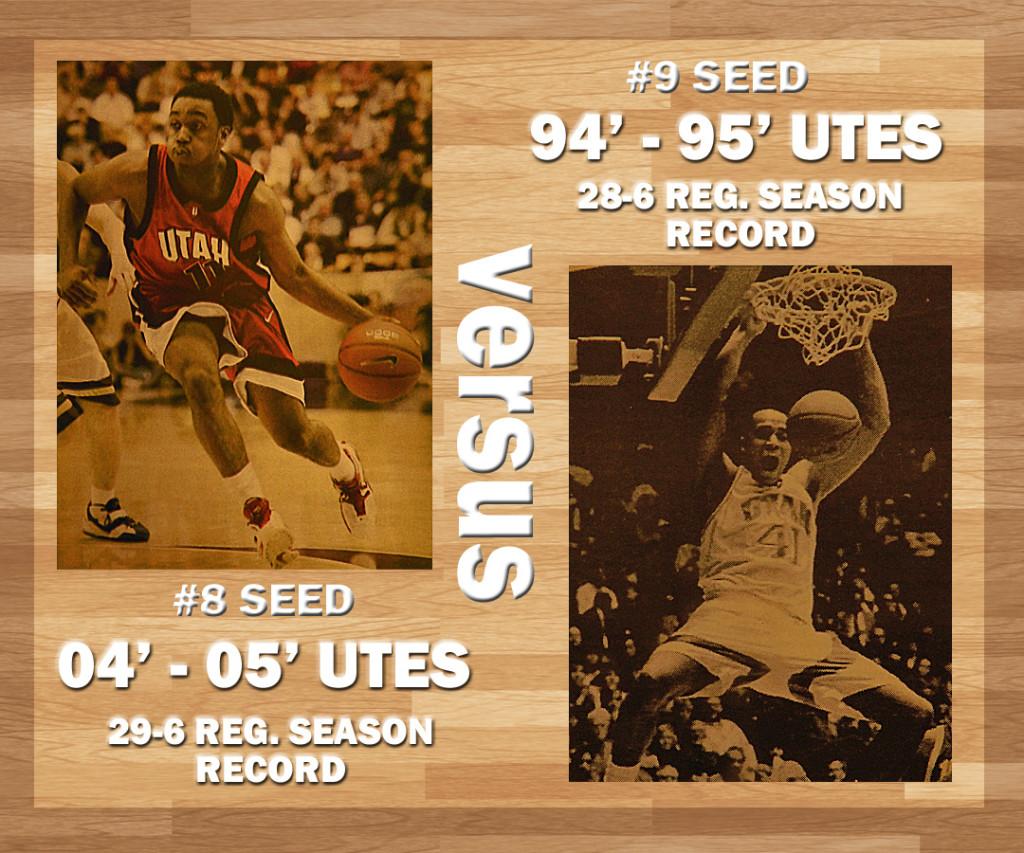
by Emilee White
If the Utah team from ‘04-’05 took on the ‘94-’95 Runnin’ Utes in a classic 8-seed vs. 9-seed matchup, the team from the 21st century would pull out the win. Though the ‘04-’05 team competed in more games than the ‘94-’95 team, the former had a better overall record at 29-6, compared to the 28-6 record from its counterparts.
Even with the better record, the squad from the ‘90s still would have a good possibility of winning the game because they knew how to put the ball in the hoop. For example, each team took on Colorado State during their respected time, both winning the game. The only difference is that ‘04-’05 team won by 14 points (64-50), while the ‘94-’95 team won by an intimidating 35 points (92-57).
A high-scoring team, such as the ‘94-’95 Utes, always has a chance in the today’s game, but behind a consistent attack from a team that eclipsed the 30-win mark, the Runnin’ Utes from ‘04-’05 advance to the next round.
WINNER: 04′ – 05′ Utes
Conclusion: No Cinderellas This Year
The higher-seeded Runnin’ Utes teams swept their opponents in the first round, setting up a clash of high-powered basketball giants in the next round of Elite Eight. Will that trend continue or will we see some upsets? Find out next week when we continue our mission to determine the best Utah basketball team of all time.
Next week’s matchups:
1) 59′ – 60′ Utes vs. 8) 04′ – 05′ Utes
2) 97′ – 98′ Utes vs. 7) 80′ – 81′ Utes
3) 90′ – 91′ Utes vs. 6) 43′ – 44′ Utes
4) 54′ – 55′ Utes vs. 5) 98′ – 99′ Utes



